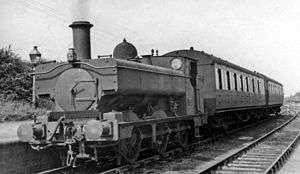GWR 2021 Class
The GWR 2021 Class was a class of 140 0-6-0 saddle tank steam locomotives. They were built at the Wolverhampton railway works of the Great Western Railway between 1897 and 1905. 1897 was the very year of George Armstrong's retirement, so it is uncertain if the design should be attributed to him or to his superior at Swindon, William Dean.
| GWR 2021 Class | |||||||||||||||||||||||||||||||||||||||||||||||
|---|---|---|---|---|---|---|---|---|---|---|---|---|---|---|---|---|---|---|---|---|---|---|---|---|---|---|---|---|---|---|---|---|---|---|---|---|---|---|---|---|---|---|---|---|---|---|---|
 No. 2080 at Berkeley Road station 1948 | |||||||||||||||||||||||||||||||||||||||||||||||
| |||||||||||||||||||||||||||||||||||||||||||||||
| |||||||||||||||||||||||||||||||||||||||||||||||
| |||||||||||||||||||||||||||||||||||||||||||||||
| |||||||||||||||||||||||||||||||||||||||||||||||
| GWR 2101 Class (differences from 2021 Class) | |||||||||||||||||||
|---|---|---|---|---|---|---|---|---|---|---|---|---|---|---|---|---|---|---|---|
| |||||||||||||||||||
| |||||||||||||||||||
| |||||||||||||||||||
In fact the 2021s were simple enlargements of the Armstrong-designed 850 class of 1874. The changes were fundamentally confined to a longer wheelbase to permit fitting of a larger firebox.
History
The class was built in eight batches:
- 2021-2030 (Lot D3, 1897)
- 2031-2040 (Lot F3, 1897-8)
- 2041-2060 (Lot G3, 1898-9)
- 2061-2080 (Lot H3, 1899-1900)
- 2081-2100 (Lot J3, 1900-01)
- 2101-2120 (Lot K3, 1902-3)
- 2121-2140 (Lot L3, 1903-4)
- 2141-2160 (Lot M3, 1904-5)
Rebuilding with Belpaire fireboxes commenced in the early years of the Churchward era. Unsuccessful attempts to form a saddle tank around the firebox directly led to the switch to pannier tanks. The rebuilding of the whole class took place over many years. In their final form, with or without fully enclosed cabs, 110 of them survived into British Railways ownership, the last of them being retired in 1956. They were superseded by the short-lived GWR 1600 Class, nominally a Hawksworth design, but in reality a straightforward update of the then 75-year-old design, with new boiler, bigger cab and bunker.
References
- le Fleming 1958, p. E50.
- Whitehurst 1973, p. 152.
- le Fleming 1958, p. E5.
- le Fleming 1958, p. E11.
- Whitehurst 1973, pp. 21-23.
- le Fleming 1958, p. E51.
Sources
- Ian Allan ABC of British Railways Locomotives, 1948 edition, part 1, pp 16,51
- le Fleming, H.M. (April 1958). Part 5: Six-coupled Tank Engines. The Locomotives of the Great Western Railway. Oxford: RCTS. ISBN 0-901115-35-5. OCLC 500544510.CS1 maint: ref=harv (link)
- Whitehurst, Brian (1973). Great Western Engines, Names, Numbers, Types and Classes (1940 to Preservation). Oxford, UK: Oxford Publishing Company. ISBN 978-0-9028-8821-0. OCLC 815661.
See also
- GWR 0-6-0PT – list of classes of GWR 0-6-0 pannier tank, including table of preserved locomotives